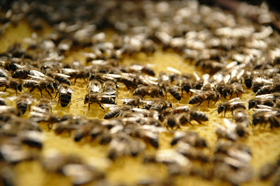Chemicals Implicated

Recent bans in Europe attest to the growing concerns surrounding pesticide use and honeybee decline. EPA had identified over 70 pesticides that are highly toxic to bees. Here are the main classes of pesticides that have been linked with bee losses and pollinator decline.
Neonicotinoids
Neonicotinoids (neonics) are a class of insecticides that share a common mode of action that affects the central nervous system of insects, resulting in paralysis and death. Studies show that neonicotinoid residues accumulate in pollen and nectar of treated plants and represent a potential risk to pollinators. AS a result of this and their pervasive use, there is a major concern that neonics play a major contributing role in pollinator declines.
Neonicotinoids are also persistent in the environment, and when used as seed treatments, translocate to residues in pollen and nectar of treated plants. A little as one seed is enough to kill a songbird. These pesticides also contaminate waterways and are highly toxic to aquatic organisms.
The case of the neonicotinoids exemplifies two critical problems with current registration procedures and risk assessment methods for pesticides: the reliance on industry-funded science that contradicts peer-reviewed studies and the insufficiency of current risk assessment procedures to account for sublethal effects of pesticides.
Imidacloprid
Clothianidin
Thiamethoxam
Acetamiprid
Thiacloprid
Sulfoxaflor
Registered first in 2013 with great controversy, sulfoxaflor is a new insecticide of the sulfoximine class and has a chemical profile similar to neonicotinoids. After a court decision, EPA reregistered sulfoxaflor in 2016 restricting applications in attempts to reduce exposure to bees. But even with reduced use sites, and restricted application timing, the systemic toxicity of sulfoxaflor ensures that these measures will not be adequately eliminating the use of this chemical.
Pyrethroids
This class of chemicals has also been shown to impair bee learning and foraging behavior. Pyrethroids are frequently associated with bee kills and have been found to significantly reduce bee fecundity, decrease the rate at which bees develop to adulthood, and increase their immature periods. Pyrethroids are widely detected in pollen.
Commonly used pyrethroids include Bifenthrin, Deltamethrin, Cypermethrin, Phenothrin, and Permethrin.
Fipronil
Widely used for indoor and turf pest control, fipronil is an insecticide that is highly toxic to insects. It is moderately toxic and has been linked to hormone disruption, thyroid cancer, neurotoxicity, and reproductive effects. Fipronil has been shown to reduce behavioral function and learning performances in honeybees.
Organophosphates
Organophosphates like malathion and naled, are used in mosquito control programs that can put bees at risk. Both are highly toxic to bees and other non-target organisms, and bee kills associated with ULV spraying have been reported. Residues on plants and other surfaces left behind from mosquito spraying indirectly expose bees to these pesticides. Pollen, wax, and honey have all been found to contain residues.
Commonly used organophosphates:
Malathion
Naled
Chlorpyrifos
Dichlorvos
For other bee-toxic pesticides, visit the Pesticide Gateway








